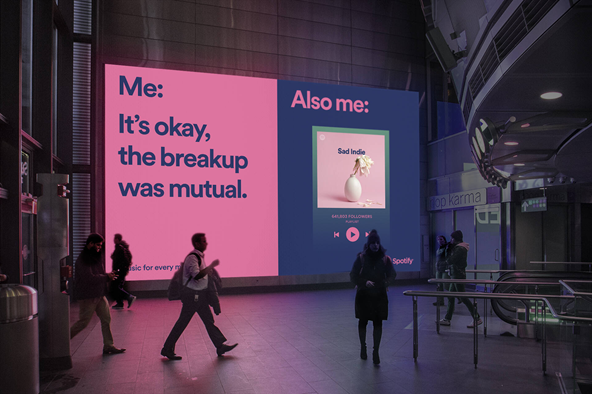From 2020 till now, it seems the bad news is never-ending. From a pandemic to a war, now we have to contend with the cost-of-living crisis. Aye, yai, yai. What next?! We all sigh, deliberately not clicking on the latest monkeypox article. To quote TikTok, we do not have the capacity.
Rising energy bills, sky-high inflation rates and stagnant salaries mean people are now having to choose which streaming service to sacrifice to save a few quid a month.
It’s probably no coincidence that at the mere whisperings of Netflix switching to an ad-based model, they became the easy choice to chop. Rude.
So what’s an advertiser to do? In these serious times, humour will be a very powerful tool to connect with audiences.
Psychology Today states that ‘Humour, the capacity to express or perceive what’s funny, is both a source of entertainment and a means of coping with difficult or awkward situations and stressful events. Although it provokes laughter, humour can be serious business. From its most light-hearted forms to its more absurd ones, humour can play an instrumental role in forming social bonds and releasing tension’.
And we need a laugh now more than ever. But not just because of the emotional reward for audiences, but the commercial ROI for brands: people are more likely to remember something funny than sad. According to research, ‘The humour effect is a cognitive bias that causes people to remember information better when they perceive it as humorous.’
Also, as people seek out more authentic stories and transparency from brands, humour is an effective way of telling the truth in a human way.
Advertising, as we know, drives culture, and when the chips are down it’s our job to counteract this with communications that make people smile, and probably sell some chips in the process.
We asked ourselves when thinking about the cost-of-living crisis, is it right to be funny? Humour is of course subjective and nuanced. There isn’t one way to make people laugh. From slapstick to wry to dark to irreverent, being funny comes in many forms. We can all agree it’s the best way to get someone’s attention and keep it. Let’s look at five brands using humour to land their brand messages, and why it works.
SKITTLES
Humour lever: Supreme honesty
Bron: We can always count on Skittles for laughs, but their Lime Apology campaign is a great example of taking a hard truth and making it funny. From the personalised responses to Tweets to their apology tour, this was a comedy master class in begging for forgiveness.
Loren: Skittles know that the expectation from their communications is high. Time and time again they show up in unexpected ways. What could have been a very straightforward brief for a flavour launch became a hysterical brand-building, award-winning piece of work.
TIKTOK WITH ANT & DEC
Humour lever: Celebrity
Bron: You have to love Ant and Dec for attacking any brief no matter the task with their signature enthusiasm and charm. They may not be the obvious choice for selling TikTok, but they stayed true to their silly selves and made the social media platform feel warm and accessible in the process.
Loren: A TV ad for social giant TikTok? A TV ad?! Shock horror. But a masterful use of humour to drive a new audience to the platform. And, because many of us are trying to save a bit of cash by not going out, TikTok shows that it is a stimulating alternative to traditional forms of entertainment. Plus I am a Geordie and Ant & Dec are my religion.
EXTRA GUM
Humour lever: Exaggerated realness
Bron: Sometimes advertising is a mirror to real life, and others, a chance to look at how life could be. While for many of us, the pandemic did not end with rolling around and making out in sprinklers, it’s a perfect comedic take on how life could be. From the track choice to the detail in all the people emerging from lockdown, we love comedy that goes big.
Loren: We all missed out during the pandemic, the biggest miss? Snogging. It would have been easy for Extra to create a warm and cuddly ad about togetherness. But a post-zombie apocalyptic romp to a Celine banger is way better. At the end of the day, they are a chewing gum brand, and they aren’t over-promising. At its heart, this ad is an incredibly good product demo.
SPOTIFY
Humour lever: Data-driven jokes

Bron: By the end of Q1 2022, Spotify had 188 million subscribers, a 15% increase from 2019. What we listen to says a lot about how we feel and are choosing to cope with life. We love how Spotify continues to spin their data into advertising that is funny, truthful but also uses social tropes and language. These ads are a great example of poking fun at something sad. It’s funny, because it’s true.
Loren: UB40, U B 40. If I wrote that piece of copy I would just retire – it doesn’t get any better. Using customer data and playing it back in this way is a thing of beauty. It allows Spotify to ‘hero’ people’s tastes in a way that feels self-aware and joyous. It’s also an unexpected use of media. As Spotify is an online music service, OOH isn’t the first medium that would spring to mind for this campaign. But by using sharp, witty copy and clean simple art direction, I can hear the sound of the ad without any audio.
BT
Humour lever: Surrealism
Bron: It’s been fun to watch BT’s advertising evolve from heartwarming family spots to just totally leaning into Wi-Fi woes dramatised through surreal comedy. I’m here for it.
Loren: BT are the backbone of communications in the UK, and during the pandemic having reliable Wi-Fi was a must. Positioning their broadband offering as ‘unbreakable’ was a bold statement. The campaign played into the emotion of when your Wi-Fi goes down… that sinking feeling of doom where every second feels like 14 years. With a series of surreal, unnerving and slightly sinister ads, they showed up in a way that feels light years from the traditional ‘BT family’ style ads of the past. When your router starts blinking or the buffering wheel spins, it does feel like your own personal nightmare.
YORKSHIRE TEA
Humour lever: Celebrity/real words
Bron: From Sean Bean’s rousing meeting to Patrick Stewart’s leaving speech, Yorkshire Tea are master blenders in theatrical comedy with a twist of bleakness.
Loren: As a brand that is part and parcel of daily routines across the country, it would be an easy win to do some ‘chatting over a cuppa advertising’, instead they’ve injected passion and humanity in an unexpected way. But the humour feels very true to the brand, they almost mock their own passion for tea and perfection.
So, what have we learned? Well, when the world is desperately looking for silver linings, the last thing audiences want is reality played back to them in an endless loop of lukewarm, sentimental ads. People want to laugh. We must help brands fine tune what humour works for them and harness it in a way that feels authentic to their audience.
Humour is powerful and it’s more than a passing giggle. In fact, studies show ‘that laughing fires up and then cools down your stress response, and it can increase and then decrease your heart rate and blood pressure’. We certainly are in need of this, every time we switch on the news. While it’s important that advertisers continue to address the cost of living with price-driven comms and introducing very necessary value ranges, providing even emotional relief is important too.
As advertisers, we can’t solve people’s very real problems, but we can ensure we are not adding to the noise and spiral of negativity projected by society. It turns out humour in advertising is serious business.
Source: warc.com

